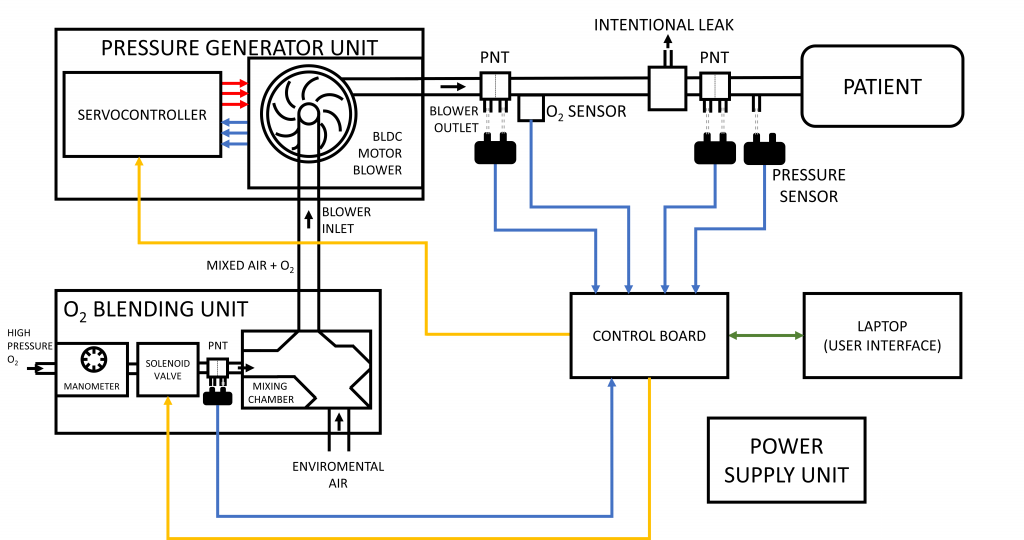Collaborations: none
Fundings: none
Subjects with impaired lung function often require respiratory support by means of mechanical ventilation. In the past, this was commonly done by the so-called invasive mechanical ventilation, which requires the intubation of the patient with an endotracheal tube and, therefore, sedation of the patient. More recently, non-invasive ventilation approach gained interest as it does not require intubation, it prevents respiratory muscles deconditioning, facilitates patients’ weaning from the ventilator and improve quality of life.
The Forced Oscillation Technique (FOT) is a method for studying the mechanical properties of the respiratory system by superimposing to spontaneous breathing, or to mechanical ventilation, small-amplitude high-frequency pressure oscillations. The complex ratio between the pressure oscillation and the resulting flow allows to compute the impedance of the respiratory system which can be expressed as function of the stimulation frequency as:

Where R is the so-called resistance, representative of the obstructive components of the respiratory system, I represents the inertance of the gas flowing into it, and C is the compliance of the respiratory system. FOT, thanks to its non-invasiveness and its independence from patient cooperation, has gained increasing attention as it is easily applicable in ICUs and NICUs.
We developed a blower-based ventilator able to provide the most common respiratory support strategies (CPAP, IPPV…) as well as to superimposed single frequency pressure oscillations to them to be exploited for estimating the mechanical properties of the ventilated subject.
The schematic representation of the ventilator is shown in Figure 1.

The pneumatic unit is composed by a brushless motor driven blower that is speed-controlled through an Electronic Speed Controller (ESC). The ESC receives the velocity set-point from a programmable microcontroller which integrates the developed firmware that implement a PID closed-loop controller on the pressure measured at the airways opening (AWO) of the subject. The ventilatory circuit is in single limb configuration to decrease its incumbrance and reduce the weight applied to the face of the subject. An intentional leak has been properly dimensioned to allow the washout of the ventilatory circuit. Pressure and flow measurement are taken at the airway opening with two differential pressure sensors synchronously sampled through an appropriately developed SPI communication system. A pneumotach (PNT) is coupled with one of the differential pressure sensors to sense the flow at the AWO. The inlet of the pneumatic unit is connected to a mixing chamber that blends the high-pressure oxygen with environmental air to produce the desired fraction of oxygen required during ventilation.
A labview-based interface allows the full control of the ventilatory modalities, it displays the traces of pressure, flow and volume measured at the AWO as well as real-time FOT parameters estimation and it saves the data for further offline analysis (Figure 2).

The ventilator allows easily management of different ventilatory modalities and the implementation of customized respiratory trials (recruitment maneuvers, non-conventional respiratory support etc.).
During its operation, the ventilator provides different ventilation modalities:
- Continuous Positive Airway Pressure (CPAP):
- Mean Airway Pressure (MAP) from 0 to 40 cmH2O
- Intermittent Positive Pressure Ventilation (IPPV)
- Positive End Expiratory Pressure (PEEP) from 0 to 40 cmH2O
- Peak Inspiratory Pressure (PIP) from 0 to 40 cmH2O
- Respiratory Rate (RR) from 8 to 60 bpm
- Adjustable inspiratory and expiratory times (Ti:Te)
- Single-frequency Forced Oscillation Technique (FOT) measurement
- Amplitude pressure oscillation from 1 to 6 cmH2O
- MAP from amplitude/2 to 40 cmH2O
- FOT Frequency from 5 to 20 Hz
- Adjustable duration (~seconds)
- Single FOT can be superimposed to CPAP and IPPV
- Amplitude pressure oscillation from 1 to 6 cmH2O
- MAP from amplitude/2 to 40 cmH2O
- FOT Frequency from 5 to 20 Hz
- Oscillations can be added on both inspiratory and expiratory phases or to one of the two only
- Minimum pressure during FOT is oscillation’s amplitude divided by 2
FiO2 can be adjusted from 21% to ~90%.
Up to now, the self-made ventilator has been involved for different studies aimed to improve the ventilatory strategies outcomes on non-invasive and invasive ventilation.
